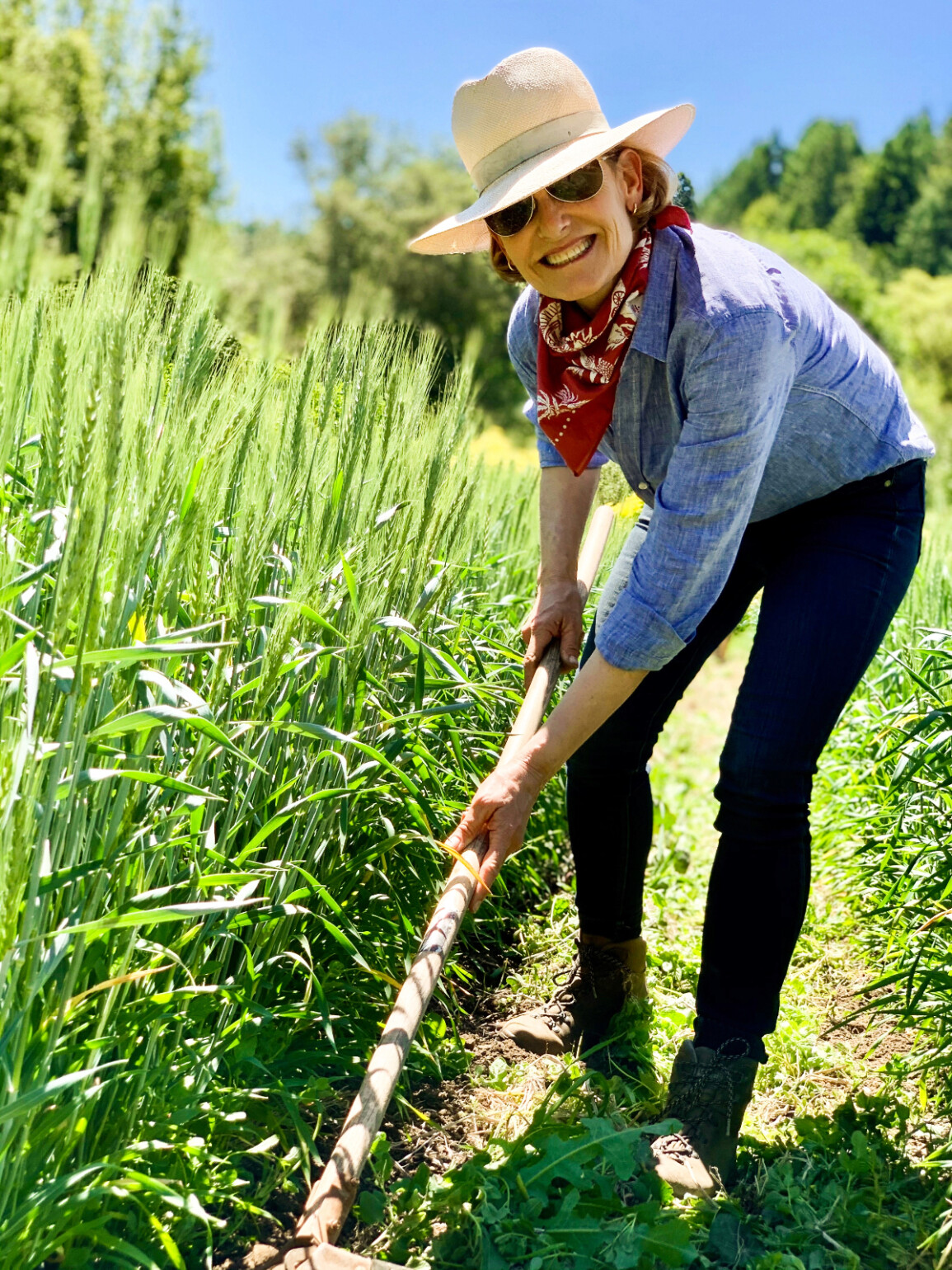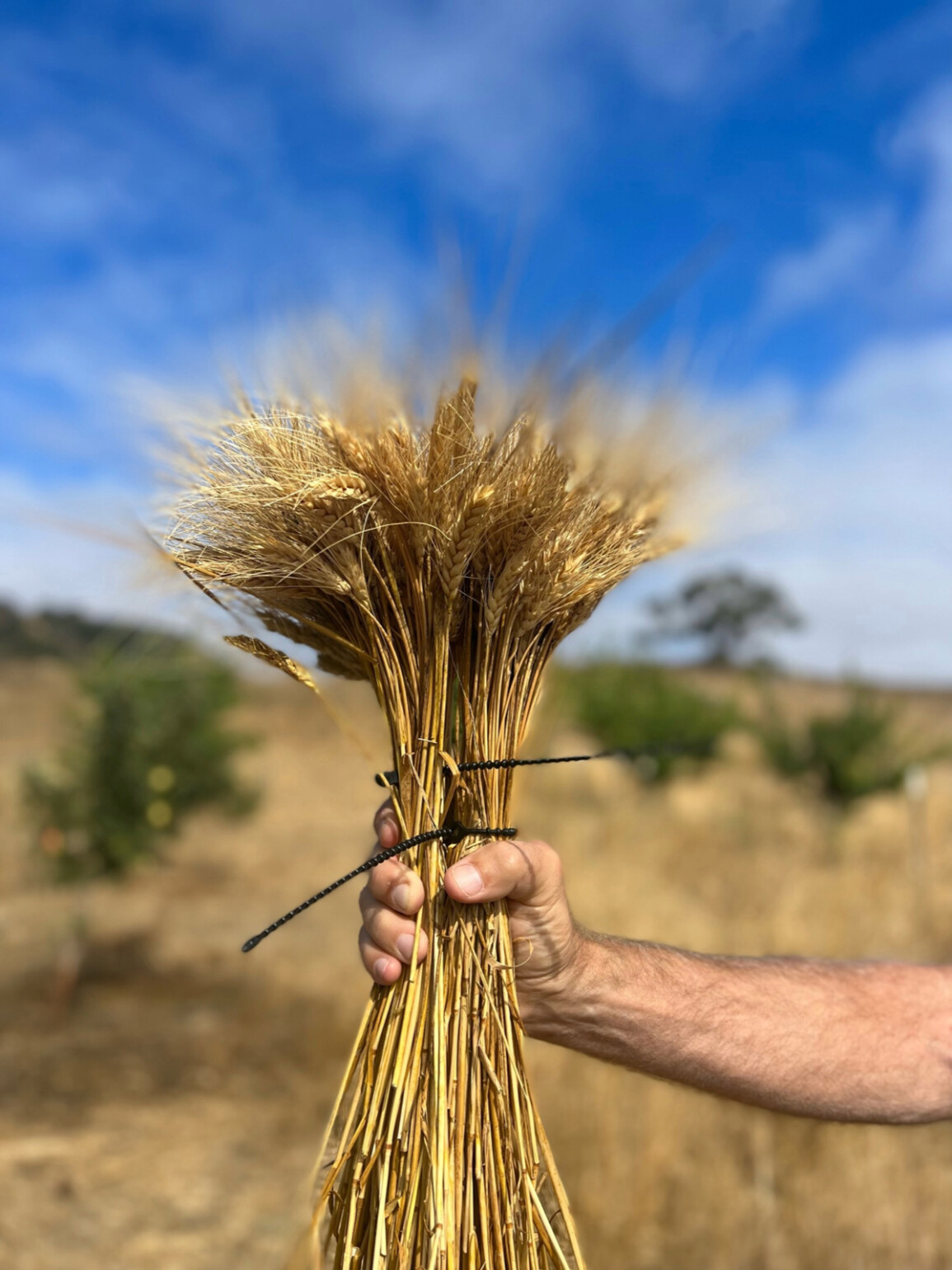Walking through a field of Hourani, an heirloom wheat farmed at Tara Firma Farm in Petaluma, felt almost religious. It was like a rite of passage for this American, raised as I was singing “America the Beautiful,” the national anthem of these United States. Marin, land of lettuces and beets, yes, but amber waves of grain? This field held something special, an heirloom crop without a Marin heritage of dairying, wine, or produce to support it.

Elizabeth DeRuff of Honoré Farm and Mill wants to change that perception. An Agricultural Chaplain, businesswoman and farmer, DeRuff set out in the early 2010s to propagate drought-tolerant wheat in support of the non-profit educational work at the heart of Honoré’s mission. Naming the 501(c)3 non-profit in honor of Honoratus of Amiens, a.k.a. Saint Honoré, the patron saint of bread bakers, flour merchants and pastry chefs, and a 7th century French bishop, was a first step. Finding the right type of wheat for Northern California’s unique climate and DeRuff’s project involved a web of seed savers and bread bakers — and Washington State University’s Breadlab in Burlington, Washington.
One Small Box for the Future

In 2019, DeRuff received a small box from the Breadlab. Inside were 300 grams (about 10.5 ounces, or a large handful) of Hourani, an ancient grain originally farmed across the Fertile Crescent, from Palestine to Afghanistan. Re-discovered in Judea during a 1960s excavation at the Masada Fortress (built by Herod the Great in 30 B.C.E.), Hourani and another variety, Jaljuli, were selected from the Breadlab’s vast seed collection as ideal candidates for DeRuff’s Northern California project. “The Breadlab sent those to me with intention,” DeRuff says. “The idea was to further not only the food itself but the spirituality of food,”
DeRuff was running a program with the students from Bayside Martin Luther King Jr. Academy in Marin City. Called Wheat Wednesdays, the program encourages learning everything about wheat — from how it is grown, to threshing and winnowing, to preparing an actual loaf. Her young crew planted modern-day seeds, valued by an ancient king for their high yield and delicious flavor, in 2020. The yield? 150 pounds of saleable Hourani. It was an auspicious start.
What is Hourani?

Hourani is a wheat landrace, a traditional crop developed over the millennia humans have farmed wheat, adapted to local conditions. It is not genetically edited to promote attributes favored by industrial agriculture. And it seems to like Marin’s (historically) cold, wet winters and hot, dry summers. When I visited that Petaluma field in June, the Hourani glistened, its pale green heads and straw-colored stalks whispering of their nutritive goodness.
Wading into the eighth of an acre plot at Tara Firma — a plot size ideal for hand planting and harvesting with volunteers and program participants — DeRuff showed me the size of the Hourani’s nearly ripe heads. Massive compared to White Sonoran, another landrace wheat DeRuff is growing under the same Marin-Sonoma conditions, its heads are nearly twice as wide and a third longer than the Sonoran. It easily spanned the length of my hand. With this simple ‘show of hands,’ Hourani’s viability as an important source of the ancient world’s calories was immediately apparent. “Wheat currently accounts for 20% of the world’s calories,” says DeRuff, a reminder of wheat’s global importance. Her Northern California Hourani could be something, its remarkable heft a promise of high future yields.
DeRuff’s Hourani is regeneratively farmed, one player in a crop rotation system that sequesters carbon and interrupts disease cycles. Hourani flour requires 95% less water than conventional flour. Unlike conventional flour, Hourani’s nutrients are not stripped out before it is turned into bread. And it is planted and harvested by the local community and returned to the community: in addition to selling to local bakers like Craig Ponsford and sales at the Saturday Farmers’ Market in Larkspur (the proceeds of which support the non-profit’s educational efforts), DeRuff works to supply three Marin school districts and one private school with grain and flour for their educational programs.
The Human Health Benefit

Hourani’s chromosomal structure and non-manipulated gluten structures are also beneficial to human health. Where modern wheat has six sets of chromosomes, Hourani, a form of durum wheat (Triticum turgidum ssp. Durum), has three sets. (Einkorn has two sets.) No foreign genomes have been added to Hourani, nor has its protein structure — the glutenin and gliadin that are present in all wheats — been manipulated. “It has not been hybridized,” DeRuff says. “It is still in its original genetic form.” Like emmer, einkorn, farro and other so-called ancient grains, Hourani’s decidedly unmodernized protein and starch content are more in synch with human digestion. Bran and natural oils remain after milling, further boosting the nutritional content and prebiotic fiber. “It’s simpler in Hourani,” says DeRuff. “When eaten whole, it is easier to digest.”
Designed for educational use and as a test plot to propagate other varieties, DeRuff’s eighth of an acre at Tara Firma is a small part of the 14 acres currently under cultivation at Sebastopol’s Green Valley Farm, at Full Belly Farm in Guinda, and other farms willing to provide acreage to Honoré. Partners such as Good Earth Natural Foods, Patagonia, Clif Family Foundation and others fund Honoré’s farming work via the Crop Adopt program and its educational programs. While DeRuff works to secure funds for a mobile stone mill to process the grains on each farm where Hourani is grown, a miller in Eureka crushes the grains into a coarse flour. Marin’s Rustic Bakery turns it into shortbread.
Now five years into the Hourani project, DeRuff, like countless growers before her, is growing in leaps and bounds. Twenty twenty one’s harvest of 3,200 pounds yielded 10,500 pounds on six and a half acres in 2022. Her take this year? More than 25,000 pounds. Amber waves, indeed.

Christina Mueller is a long-time Bay Area food writer. She hails from the East Coast and has spent way too much time in South America and Europe. She discovered her talent as a wordsmith in college and her love of all things epicurean in grad school. She has written for Condé Nast Contract Publishing, Sunset, and the Marin Independent Journal, among others. She volunteers with California State Parks and at her childrens’ schools, and supports the Marin Audubon Society, PEN America, and Planned Parenthood. When she is not drinking wine by a fire, she is known to spend time with her extended family.


